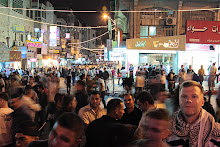My first reflections upon reading about the Jerusalem Project and the 1993 Folk Festival were that my impressions of Jerusalem and its contested nature were pretty much spot-on. I don't mean to pat myself on the back, because to me, the complexities of representation and perception regarding Jerusalem are palpable, omnipresent, and abrasive.
In other words, you can't spend 10 minutes in Jerusalem--especially in the Old City--without tripping over the tangled mess of how different people perceive Jerusalem, and how everyone's subjective position determines what they perceive as 'objectively' Jerusalem. My first day in Jerusalem, I saw a Palestinian shopkeeper being accosted by Israeli Police because he didn't have his trash can in the right place. Perhaps to the shopkeeper, Jerusalem is his livelihood. Perhaps to the police, Jerusalem is a dangerous place--a powderkeg of contrary political and economic realities. To the tourists giving a wide berth to the argument, Jerusalem is a holy city with a conflict that
would just go away if everyone would just find Christ (italics indicate my sarcasm here). To me, the geographer looking for moments of contention between groups, Jerusalem is a battleground of quotidian conflicts.
So we each bring our respective baggage to Jerusalem, and see the city through tinted lenses--and many assume that everyone sees (or
should see) the city the same way. This subjectivity isn't restricted to how we perceive the city and its denizens (and its visitors), but extends to the history and the folkways of the city, as well as how the city is represented thousands of miles away, in and around the halls of power in Washington, DC.
Enough of my musing; I should respond specifically to the readings for this week.
The Hasan-Rokem paper hit squarely on the target painted by Homi Bhabha's
Location of Culture. As in my musings above, Hasan-Rokem spends a great deal of thought on representation and the performative aspects of culture. Israel (and especially Jerusalem) is a terrain populated by history and revanchist cultural practices--practices that, to one degree or another, seek to connect to and perpetuate history. Sukkot, Purim, and other holidays are important to Jewish culture and religious practice, but also gain importance through their commemoration on Israeli soil. I feel that Hasan-Rokem has captured quite a bit of the ambiguity and difficulty of representing Jerusalem and its polyglot culture, but I can't help but wonder if he simplified things a bit--because Jerusalem isn't just a contest between Israeli and Palestinian, Jew and Muslim: Jerusalem is also a product of Armenians and Orthodox, of wealthy tourists and dispossessed families, of first-world technology and economics clashing with Iron Age archaeology and 19th-century infrastructure.
The
Representing Jerusalem piece from Middle East Report is remarkable to me most because the text shows its age. 1993 was a moment of hope and possibility, and there was a palpable feeling that things would only get better--and they did, to a degree, for a while. Thus, the "most difficult problem" of the project is
contextualization, in order to keep the threads untangled and prevent the Jerusalem Project from becoming "a caricature of itself." Never mind the grinding reality of ongoing conflict in and around the city, especially in the 21st century: in 1993 we just had to figure out how to be equanimous, how to be "fair and balanced" without going overboard.
Which is why
Researching East Jerusalem feels more in-tune with (my) reality: Amiry talks about peasant women, teenagers, drugs, and crime. Sometimes we focus so much on the elephant in the room, we forget that Jerusalem is a city with problems like other cities. And
that context is important to keep and remember, as well.
Finally, one bit of
Living Jerusalem: Cultures and Communities in Contention really stood out for me: defining and delimiting the research process, particularly in terms geographical boundaries (hey, I
am a geographer) and what is "contemporary." Jerusalem is a place where "contemporary" is particularly problematic--not just because of the age of the city, but because (as I mentioned above) how groups and individuals bring historical practices (and myth) to the present in efforts to reinforce their claims on space in the present.
Overall, I find two themes tie together the readings for me. First, as I've blathered on quite a bit already, Jerusalem is a quagmire of meaning and contested context. Second, 18 years ago, we could spend time and energy worrying about the politics of representation in an academic setting; nowadays, the politics of representation is
geopolitics. When Bibi pronounces that "East Jerusalem is not a settlement," it's clear that what is at stake is a lot more than getting an ethnographic project done right.




